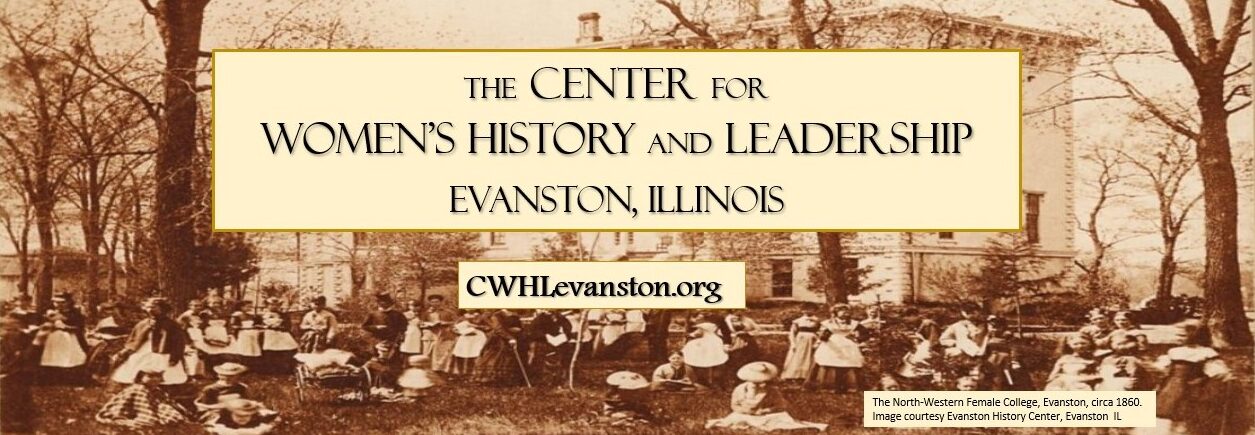By Janet Olson, Archivist
See Part 1 and Part 2 in this series for the beginning of the story.
The Evanston College for Ladies (ECL), founded by the Women’s Education Association (WEA) and led by President Frances Willard, opened in September 1871, with 236 students. Of these, 37 were following a “collegiate” track, taking courses at Northwestern University, per the agreement between the WEA and Northwestern. However, the ECL and its president were soon faced with circumstances that changed the future of coeducation in Evanston, and of Willard’s role.
The Great Chicago Fire began on October 9, 1871, just one month after the ECL opened, and three months after Willard’s triumphal Women’s Fourth of July event that raised $30,000 in pledges for the ECL’s new building. Along with the homes and businesses that went up in smoke during the fire, so did the fortunes of the men who had pledged funds to the ECL.
Now short of money, the WEA spent the next two years scrambling to meet Evanston’s five-year deadline for construction of the ECL’s building on the plot of land the town had donated. Fundraising – through lectures, pamphlets, and letter-writing – was unproductive, with so many funders bankrupted and so many other institutions also seeking funds to rebuild after the Fire.
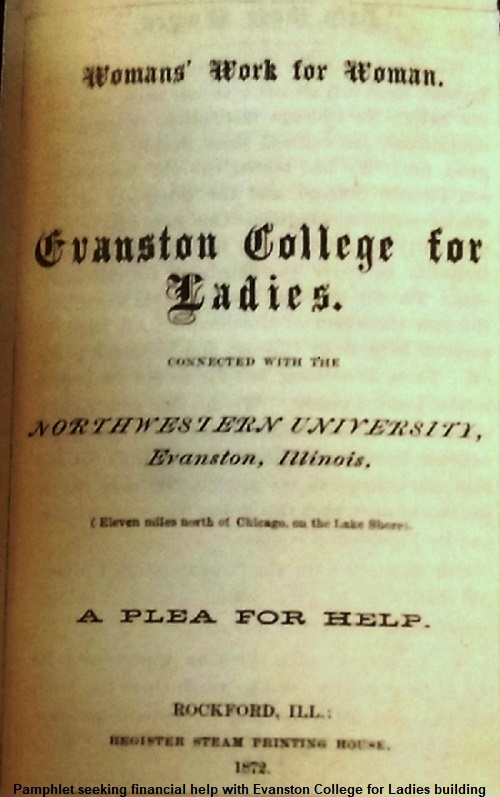
Still, the ECL attracted students and faculty. However, the WEA reluctantly reached the conclusion that an official merger with Northwestern was the only way to keep the ECL alive. The Evanston College for Ladies held its first – and last – commencement in June 1872, after just two full years of operation.[1]
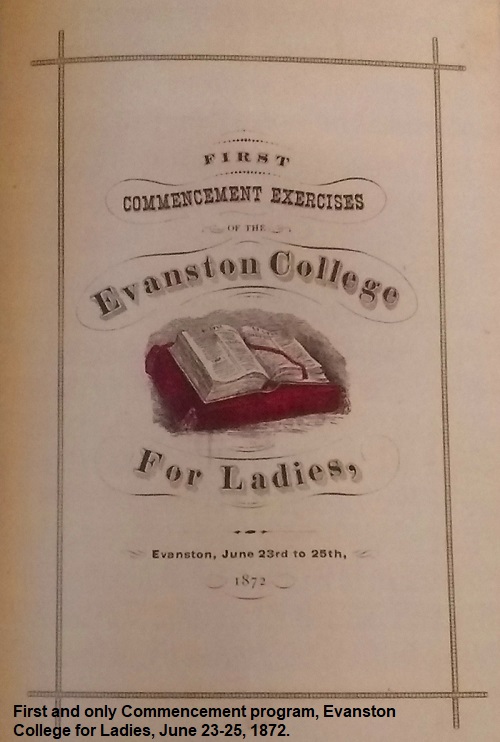
Negotiations between the WEA and Northwestern began in the spring of 1873. On June 25, 1873, the WEA voted to adopt a consolidation with Northwestern University, on the following terms:
- The ECL would become a Department of the University, and be renamed the Woman’s College of Northwestern
- Northwestern would complete the construction of the Woman’s College building
- A Dean of Women would be appointed to supervise the women students
- At least five women would be appointed to serve on Northwestern’s Board of Trustees
- ECL faculty would be given preference for positions at the Woman’s College
With this agreement, the Evanston College for Ladies became the Woman’s College of Northwestern University, and the WEA was dissolved.[2]

Five women were added to Northwestern’s Board of Trustees: Elizabeth Greenleaf, Elizabeth Huntington Miller, Kate Queal, Mary Bannister Willard, and Jenny Fowler Willing. The Chicago Evening Mail reported: “thus the Northwestern University becomes the first institution in the world to inaugurate the co-representation of the sexes in the government of colleges.”
For one dollar, the WEA sold Northwestern the partially built ECL building. Northwestern /completed the construction, and women students were finally able to move in by the winter term of 1874.[3]
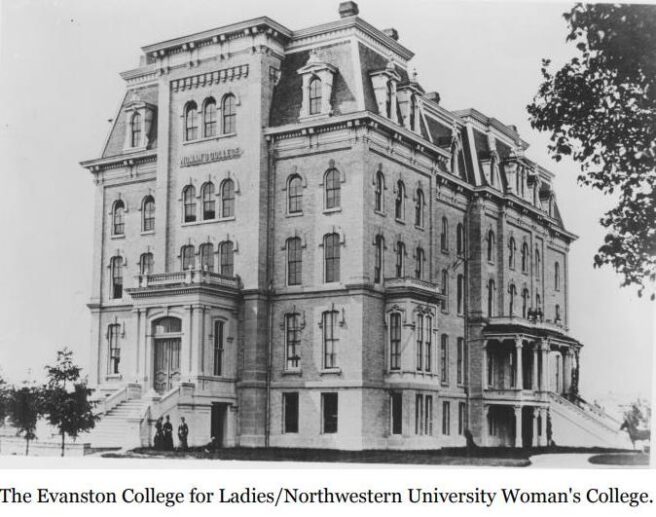
The Northwestern catalog for 1873-74 stated that “Ladies are admitted to the College of Literature and Science, and to the College of Literature and Art [the Woman’s College]; and to the Faculties and to the Board of trustees.”[4]
Most important for our story, the separation of the schools’ administrative units ended, and Frances Willard, no longer the president of a woman’s college, was elected the first Dean of Women at co-educational Northwestern University, at an annual salary of $1,800. She was also elected Professor of Aesthetics, a full professorship – a very rare honor for a woman, at that time and well into the twentieth century.
In September, Dean Willard received a letter of congratulations on her appointment from Erastus O. Haven, the Northwestern president who brought coeducation to the University in 1869, and who had continued to be a friend and supporter to Willard after he left Northwestern in 1872. The letter was significantly addressed to “Professor Willard.”
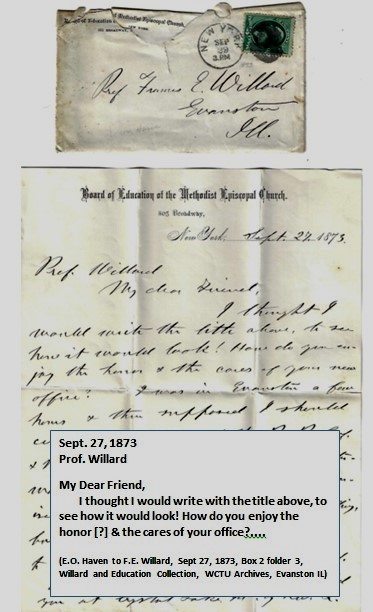
Although Willard gave up the title of college president, as Dean and Professor she retained the leadership role of supervising and directing the young women attending the University. However, despite the support of the women now on Northwestern’s Board of Trustees, she would find that her authority with University administration – especially the president – had unexpected limits. Within a year, these challenges would convince her to leave the field of education completely and find a new vocation with the Woman’s Christian Temperance Union.
Sources include:
“On the Same Terms”: The Beginnings of Women’s Education at Northwestern, Janet Olson (exhibit catalog, NU 2019; digitized 2023)
Frances Willard Scrapbook # 3 pp 95-99, WCTU Archives
Frances Willard and Education Collection, WCTU Archives
[1] With the ECL building unfinished, women students lived and attended some classes in the old Northwestern Female College building at Lake Street and Chicago Avenue.
[2] The Women’s Educational Aid Association, founded in 1871, still supports women students today.
[3] The ECL/Woman’s College building still stands at 711 Elgin; it served as a women’s residence hall until 1938, then as Northwestern’s Music Administration Building until 2015.
[4]The excluded departments were the colleges of Technology, Theology, Law, and Medicine.
